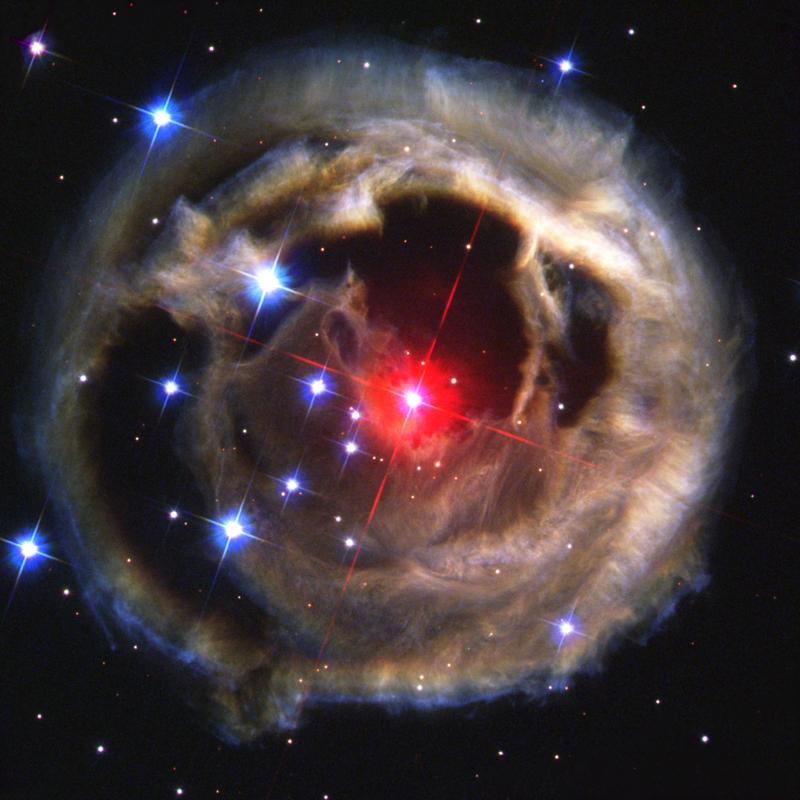







| BOOKS | F. A. Q. | ARTICLES | TALKS | ABOUT KEN | DONATE | BEYOND OUR KEN |
|---|
By Ken Croswell
Published on Nature (December 7, 2010)

Hubble Space Telescope. NASA, ESA, and Howard E. Bond (STScI)
For the first time, astronomers have watched the spiralling dance performed by two stars merging into a single star. The observations, taken between 2001 and 2008, suggest a solution to the problem of how rare "red novae" form.
Most novae are blue and occur when material on a white dwarf star explodes. But what causes red novae has been a mystery.
The best-known red nova was spotted in January 2002 toward the edge of our Galaxy's disk. Named V838 Monocerotis and shown above, it was more luminous than normal novae--at peak brightness, it briefly rivalled the most powerful stars in the Galaxy. Red novae have also erupted in other galaxies.
In September 2008, the red nova V1309 Scorpii appeared in the Milky Way. Fortunately, it was positioned in a part of the sky being watched by the Optical Gravitational Lensing Experiment (OGLE), a Polish-run program using data from a telescope at the Las Campanas Observatory in Chile to search for signs of dark matter and planets. As a result, the team had inadvertently captured the process that sparked the red nova.
"The material is fantastic," says Romuald Tylenda, an astronomer at the Nicolaus Copernicus Astronomical Center in Torun, Poland. "I never expected to see so many observations before an eruption." From 2001 to 2008, the OGLE team had observed the pre-nova star a remarkable 1,340 times. In a paper submitted to Astronomy and Astrophysics, Tylenda and his colleagues say that the red nova was created by the merger of a double star system known as a contact binary.
A contact binary consists of two stars that circle each other so closely that they touch. If viewed from an orbiting planet, the stuck-together suns would resemble a glowing peanut-shaped object. Exotic though they seem, contact binaries are common: the nearest, named 44 Bo�tis B, is just 41 light-years from Earth.
Because they are so close together, the two stars continually eclipse each other, causing the brightness we see to vary. This allowed Tylenda and his team to deduce the nature of V1309 Scorpii, which is roughly 10,000 light-years from Earth.
Before the explosion, the two stars danced around each other every 1.4 days. As they spiralled together, this period shortened until the stars merged and exploded, upping their brightness by 10,000 times. Tylenda and his colleagues estimate that the larger star had about as much mass as the Sun. Current observations indicate that the system is now single.
"It certainly is a very exciting discovery," says Howard Bond, an astronomer at the Space Telescope Science Institute in Baltimore, Maryland, who was not part of the discovery team. "This is clearly something that we've never seen before." However, Bond cautions that the same process may not explain other red novae.
Tylenda disagrees: "I think that almost all of the red novae are mergers." In particular, he argues that the best-known red nova, V838 Monocerotis, resulted from such a merger. That explosion was more powerful than V1309 Scorpii, indicating a greater mass.
The first observational sign that contact binaries merge came in 1981, when American astronomers Bernard Bopp and Robert Stencel said a fast-spinning giant star named FK Comae Berenices was a former contact binary that had merged and become single. This star and two other fast-spinning giants stood out because most giant stars spin slowly. But when a contact binary merges, the angular momentum of the orbiting stars spins up the single merged star.
Shrinivas Kulkarni, an astronomer at the California Institute of Technology in Pasadena, describes the findings of Tylenda and colleagues as "amazing". Kulkarni notes that theories to explain red novae outnumber all the red novae known. "They've been so mysterious for so long. This discovery is a huge, huge step forward."
Ken Croswell is an astronomer and the author of The Lives of Stars.
"A stellar picture of what we know or guess about those distant lights."--Kirkus. See all reviews of The Lives of Stars here.
| BOOKS | F. A. Q. | ARTICLES | TALKS | ABOUT KEN | DONATE | BEYOND OUR KEN |
|---|